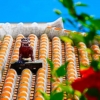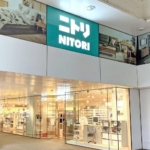Stay at an English-speaking Temple in Koyasan 👨🦲
♥Posted by Satomi♥
There are many temples in Kyoto, but do you know there are some that you can stay?
Usually only monks can stay at the temple, but now there are temples where ordinary tourists can stay, and various cultural experiences and services are available.

You can experience Zen meditation, Syakyo (sutra copying) and Buddhist cuisine which are unique to the temple, and it will deepen your memory of the trip.
If you go sightseeing in Kyoto, why don’t you stay at a temple?

There are 117 temples in Koyasan, a World Heritage site, of which 52 are shukubo (Accommodation).

Koyasan has been attracting increasing interest from foreign tourists in recent years, and the number of people who want to stay at shukubo is increasing rapidly.ヾ(≧ ▽ ≦)
For this reason, shukubo in Koyasan were quick to strengthen their service to foreign guests.

Among them, the two temples I will introduce to you now have a few monks who are fluent in English, and you will be able to receive a thorough explanation of everything from lodging to Buddhist teachings.
Ekoin Temple
Ekoin Temple offers a wide range of free activities, including meditation, sutra copying, and morning temple work.

You can also experience Buddhist cuisine. You can enjoy healthy menus such as dishes made with Koyasan’s sesame tofu.
The room is a private room with a nice view and it is like a ryokan.
There are tables and chairs on the veranda, from which you can enjoy the well-maintained garden.✿

The entrance of the room is Fusuma. Let’s put your valuables in the safe in your room. Rooms at nearby entrances don’t let guests in, and they consider the privacy of guests.
The toilet is shared (Western-style shower toilet) and the bath is a large public bath.(*^_^*)
The large public bath is small compared to the capacity of the guest rooms, but most of the guests go to Okunoin Cemetery Night Tour, so you can use it comfortably from 19 to 21 o’clock.
By the way, you can take a bath in the morning.

The view of the garden from the room is like a mountain of nature.
There is a pond and a Japanese garden on the side of the hallway, and you can enjoy the view of the garden while moving around the large building.

After you check in, you can have a sutra copying (Free) right away.
Do it when you have time in your room.

You trace the thin copy of Hannya Shingyo on the back of the paper with a brush pen.ψ(._. )>
There are 262 kanji characters, and even if you write each character with your heart, you can finish writing in 10 to 20 minutes. It has a sense of accomplishment.
If you check in early, you can participate in a meditation called Ajikan which starts at 16:30 for free.

The monk will explain carefully how to breathe, how to put your feet together, how to hold your hands together, and how to concentrate.
After about 30 minutes of meditation, both your body and mind are relaxed and natural.( *︾▽︾)
This meditation experience is open to non-hotel guests. (500 yen for non-hotel guests)
The temple work is held in the main hall from 6:30 in the morning. Participation is free.

In the main hall where you can see the principal image Amida Nyorai at the front, the statue of Fudo Myoo and the statue of Kobo Daishi on both sides, the sutra chanting by the high priest sounds.
Many foreigners also participate.
Another experience you can have at Ekoin is the Okunoin Cemetery Night Tour (Paid).
It is a tour to gather in the precincts at 7 PM and depart. You need to make a reservation online.

You can listen to stories about Kobo Daishi, Shingon Esoteric Buddhism, the legend of Okunoin, and the history of Koyasan while visiting Okunoin at night under the guidance of a monk.(⊙_⊙)?

Buddhist cuisine is usually a simple dish, but the dinner at Ekoin is substantial and filling.

Sake is prohibited as one of the five precepts of Buddhism, but it is said that ascetic monks drank it to warm themselves up in the cold winter.
In Koyasan, sake is called Hannya-to, you can drink sake, beer and so on.(❤ ω ❤)
Speaking of shukubo, you might imagine having a meal after listening to a sermon in a large hall, but at Ekoin, monks bring it to your room.

Some young monks wearing a lot of headsets are busily moving around the large building. It looks like a big restaurant.
There are a free coffee server and a tea server in the building, and it is very popular among guests. Free Wi-Fi and an internet room are also available.

There are T-shirts of Eikoin, so it is good as a souvenir or a memory of your stay.
How about a shukubo experience of Ekoin?
If you stay there, you can experience many things calmly unlike a day trip.ヾ(^▽^*)))

Also, the temple work in the morning is an experience that only guests can participate. Why don’t you try it?
Inquiries and reservations can be made online from the Ekoin website.
Ekoin Temple
Muryokoin Temple
Muryokoin temple, a Shingon Esoteric Buddhism temple located in Koyasan, like Ekoin, has been actively involved in international exchanges and has accepted ascetic monks from not only Japan but from all over the world.

It is a shukubo that inherits the traditional style, and it is one of the few places where you can enjoy the old Koyasan such as the room with sliding doors.
The first thing you see after entering the gate is the new main hall.☆*: .。.彡

It was built to commemorate the 1,200 year anniversary of the founding of Koyasan, and it has a splendid appearance that is suitable for a new history.
They also hold sermons in many languages such as English, Chinese and French.

The Swiss-born abbot has been around the temple for over 20 years and is fluent in several languages, including Japanese, making him one of the most well-known foreign monks in Koyasan.
You can talk to him during your stay if the timing is right.(・∀・)ノ
The guest rooms have beautiful wall paintings reminiscent of the times, and the traditional tatami mat rooms make you feel the shukubo of the temple.

However, the large public bath is a modern, stone-paved large public bath.
There is a real Gongyo (buddhist liturgy) which is held for an hour and a half from 6 AM.
Guests are free to participate in the event, but the monks who usually take care of guests also attend the event wearing Kasaya, so visitors can experience a solemn atmosphere.

When you participate in the morning work, you need to give a tip voluntarily.
Buddhist cuisine is simple, but there are seasonal simmered vegetables and Koyasan’s famous sesame tofu.

There are several monks who come here from foreign countries to study esoteric Buddhism and live there, and they also guide them.

The foreign monks will explain in each language, so it is a shukubo that I can recommend to foreign guests.

Inquiries and reservations about accommodation can be made by phone or online.
Also, there is no description about the accommodation fee on the website, so I recommend you to make an inquiry when you make a reservation.
Muryokoin Temple
The good point of shukubo is that you can not only visit temples with history but also stay there and experience ascetic practices.
It’s just a place for training, so you might not be able to get comfortable service like hotels and inns if the bathroom and toilet are shared or there is a curfew.

However, there are many people who are fascinated by the precious experiences that cannot be gained by just sightseeing trips, and the number of repeat customers is increasing every year.ヾ(•ω•`)o
You can expect more and more improvement in the service for foreign guests, so if you are unsure about choosing an inn in Japan, why don’t you consider shukubo as an option?

A comfortable hotel or ryokan is good, but if you stay at a temple or a shrine and review your mind through sutra copying or Zen meditation, you may be able to remember important things that you tend to forget in daily life.
Wakayama Akizuno Garten, Renovated a Japanese School 🍊














